Thinking about the chambres de bonne last month reminded me of another distinctive space found in many older Paris buildings – the entresol. It, too, provided a space where servants might sleep, unless it was being used for storage or extra commercial space or the concierge’s apartment.
The entresol is the floor between the rez-de-chaussée (ground floor) and the first floor proper (sometimes called the étage noble). If it’s a complete storey, it is an entresol; if it covers only part of the rez-de-chaussée, it should really be called a mezzanine.
The name literally means “between floors,” and that makes me think of the movie Being John Malkovich, and the scene that takes place on floor 7½ of a New York office building. Here is a still (the actor is John Cusack) and you can watch a short film clip showing how he takes the elevator to this strange space here.
But that’s New York. Entresols in Paris have a staircase for access and most of them allow people to stand up straight. This model of a “typical” Haussmannian immeuble from 1860, which can be seen in the Cité de l’Architecture et du Patrimoine, includes an entresol just above the ground floor.
The cross-section of the 1883 building that I showed in the previous blog has an entresol (in the image, it is labelled as the third floor, but its ceiling is lower than those of the floor below and the two floors above). It seems to serve as an office with a meeting room.
But entresols long predate Haussmann. They were well established when Antoine Chrysostome Quatremère de Quincy wrote his architectural dictionary in 1788. In the entry on entresols, de Quincy explains that the first entresols were additions to grand houses with high-ceilinged ground floors. Given all that wasted space overhead, it made sense to insert some extra usable floor space. De Quincy describes these early entresols as “furtive,” “concealed from the exterior of the building.”
Later, when they became a planned part of the architecture, de Quincy notes the problem of how to incorporate them into the façade: “Being usually quite low and placed below the main floors, it is easy to see that one should consider them more like an ‘hors-d’œuvre’ in the decoration of the façade rather than an integral part. One cannot apply an ‘order’ to them, because it would be ridiculously small relative to those above it.”*
De Quincy also abominated the practice of having two entresols, which he called an “abus révoltant” (a revolting anomaly), like creating a small house inside a large house.
One of the earlier examples of an entresol in Paris is that of the Palais Royal, parts of which date from the 17th century. In this image of the exterior facing the rue de Valois, you can see a long vista with arched windows just above the ground floor. (This Google Street View photograph includes the bonus of a peek inside the staircase of No. 25).
An image from the late 18th century of the “Bœuf à la Mode,” a Palais Royal restaurant, shows a sign on the stairs indicates that further tables and private rooms are located on the entresol.
Within a few minutes’ walk of the Palais Royal, you can see entresols everywhere. The Place des Victoires, created in the late 17th century by Jules-Hardouin Mansart, is awash in them. Their windows form the upper part of the arches above the doors and shop windows.
Streets such as rue des Petits Champs contain many examples. On one corner, the original windows remain.
On another corner at the same intersection with the rue des Moulins, much of the space has been filled in and the windows are smaller.
In the Place Dauphine on the Ile de la Cité, one wonders if there really is enough space to stand up straight in either the rez-de-chaussée or the entresol of certain buildings. This place dates from the early 17th century, and although most of the buildings have been altered and added to over the years, the spacing of the lower floors is probably original. Tall people, mind your heads!
At the other extreme, here is an image of 25, rue de la Harpe (built circa 1800), taken in about 1912 by the largely forgotten photographer Charles Joseph Antoine Lansiaux (1855–1939). The entresol is vast and its façade ornate.

Rez-de-chaussée et entresol, 35 rue de la Harpe. Paris (Vème arr.). Photographie de Charles Lansiaux (1855-1939). Tirage au gélatino-bromure d’argent, vers 1917. Paris, musée Carnavalet.
Entresols feature in quite a few of Lansiaux’s many Paris photos. Here is one of the courtyard behind 8, rue Royale.
One famous entresol was at No. 7, Place Vendome, the home of the Club de l’Entresol in the 1720s. It was a place for influential aristocrats to discuss politics and foreign affairs, and that, predictably, led to its demise only a few years after its inception, since discussing these sensitive topics was frowned on by King Louis XV. Alas, the actual space is long gone, although the façade facing the square survives. Whatever was once behind the façade was replaced in 1930 by a modern building with a big courtyard that you can walk through.
Many major buildings have entresols. The Louvre, of course. The Opera Garnier has two (de Quincy would not approve), mostly used for dressing rooms. Entresols are a feature of many arcades, often with windows looking into the covered shopping area. Some are offices, some are loges for the concierge, and we have eaten in more than one restaurant entresol in an arcade. You get an interesting view up from up there. Here is the Passage Choiseul, photographed by Eugène Atget.

Passage de Choiseul. Paris (IInd arrondissement), around 1907. Photograph by Eugène Atget. Paris, musée Carnavalet.
Once you start looking for them, you will notice entresols in all kinds of central Paris buildings. Hotels. Stations (well, those are really mezzanines). Here is a postcard of the Rue de la Paix from our collection, and the entresol has its own little awnings above the windows.
Probably the most famous entresol-dweller was Colette, shown here in 1930 of the Palais Royal with the unmistakably shaped window behind her. And a cat. Both looked faintly annoyed at being disturbed by the photographer – André Kertesz.
The entresol seems to have become extinct as an architectural feature during the 20th century. As with the chambre de bonne, some entresols have become bijou residences in trendy areas. In preparing this blog, I lingered over a few real estate ads for entresol apartments. They may be a bit noisier than chambres de bonnes, being much closer to the street, but then one need not use an elevator (an advantage in pandemic times). They look rather cosy.
As the Andrews Sisters used to sing, I can dream, can’t I?
Text by Philippa Campsie. Still photograph from “Being John Malkovich” from YouTube. Model of Haussmannian building from the Cité de l’Architecture et du Patrimoine. Image of the “Boeuf a la Mode” from ResearchGate. Lansiaux photos from Paris Musées. Atget photo from Paris en Images. Kertesz photo of Colette from Christies online. Other images from Google Street View or our postcard collection.
* “…se trouvant ordinairement fort bas & placé au-dessous des grands-étages, il est facile de voir qu’on doit le considérer plutôt comme un hors-d’œuvre dans la décoration d’une façade que comme devant en faire partie intégrante. On ne sauroit lui appliquer aucun ordre, car cet ordre seroit ridiculement petit eu égard à ceux qui le surmontoient” (Encyclopédie Méthodique: Architecture, p. 345).







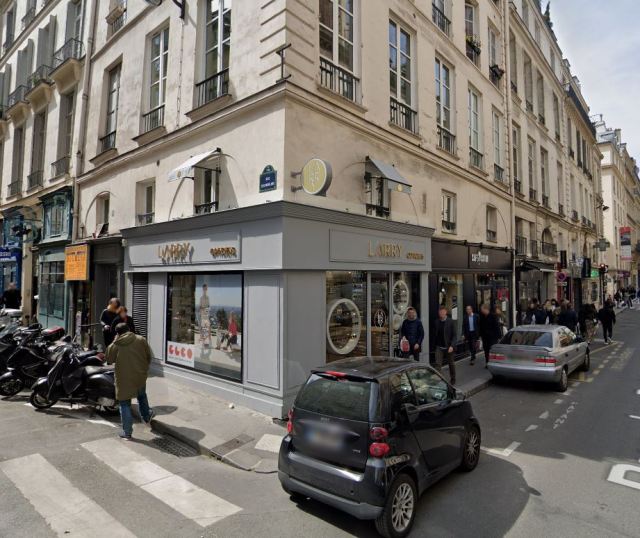







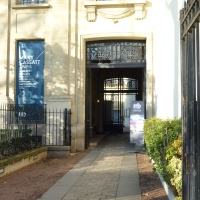


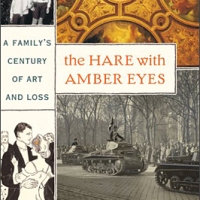

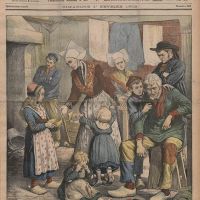

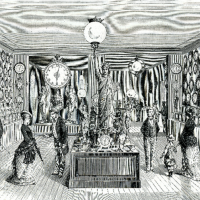









Oh! Eye-opening!! If it wasn’t pouring with rain here in central France at the moment I’d be out in the street in a trice looking for entresols!!
Raining here in Toronto, too. Let me know if you find some good ones in your town.
What a great lesson in French architecture! Of all the history I do know of France, this wasn’t among them. Now I’ll never look at another French building the same as I once did. Thanks for sharing.
I am not surprised. I had some difficulty finding information about entresols, and only a few passing mentions in architectural history books.
Another fascinating and informative post – thank you! I had wondered about what lay behind those small “first floor” windows, that aren’t considered first floor at all. I looked up Zola’s Pot-Bouile which centres on a new apartment block and its occupants. In it he describes the entresol and its residents. Edmund de Waal talks about an entire hidden servants’ floor without windows, squeezed in between the main floors of the Ephrussi palace in Vienna, in his book The Hare with Amber Eyes. Was the entresol usually accessed from the courtyard by the same staircase as the chambres de bonnes, or by an internal staircase from the shop premises on the rez de chaussée?
Apologies Parisian Fields – just found your reply to my comments on your Chambre de Bonne post – repeating myself!
Entresols could be reached by internal staircases, often directly from the shop on the ground floor, but I think various arrangements were possible.
Very interesting! Thanks.
So fascinating. I think I’ve seen them in New York too.
Now that is interesting. I didn’t know they had them there, too.
Oh I so want to go walking on the streets of Paris again and search for this architectural detail. Alas I am unable to travel from Australia at the moment. Thanks again for your illuminating post.
So do I. So do I.
Really enjoyed learning about this feature. Thank you for sharing.
And thanks for commenting.